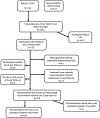Declining walking impairment questionnaire scores are associated with subsequent increased mortality in peripheral artery disease
- PMID: 23500321
- PMCID: PMC6116834
- DOI: 10.1016/j.jacc.2013.01.060
Declining walking impairment questionnaire scores are associated with subsequent increased mortality in peripheral artery disease
Abstract
Objectives: This study determined whether greater 2-year declines in Walking Impairment Questionnaire (WIQ) stair climbing, distance, or speed scores were associated with higher all-cause and cardiovascular disease (CVD) mortality among men and women with lower extremity peripheral artery disease (PAD).
Background: Associations of decline in the WIQ with mortality among people with PAD are unknown.
Methods: Participants were 442 men and women with PAD identified from Chicago area medical centers. The WIQ was completed at baseline and at 2-year follow-up. Cox proportional hazard models were used to assess associations across categories of 2-year changes in WIQ stair climbing, WIQ distance, and WIQ speed scores with subsequent all-cause and CVD mortality, adjusting for age, sex, race, ankle-brachial index, body mass index, smoking, comorbidities, and other covariates.
Results: One hundred twenty-three participants (27.8%) died during a median follow-up of 4.7 years after the 2-year change in WIQ score measurements. Forty-five participants died from CVD. Adjusting for covariates, participants with WIQ score declines ≥20.0 points had higher all-cause mortality (hazard ratio [HR]: 1.93, 95% confidence interval [CI]: 1.01 to 3.68 for WIQ stair climbing; HR: 2.34, 95% CI: 1.15 to 4.75 for WIQ distance; and HR: 3.55, 95% CI: 1.57 to 8.04 for WIQ speed, respectively) compared with participants with ≥20.0 point improvement in each of the corresponding WIQ categories. Participants with ≥20.0 point declines in the WIQ distance score had higher CVD mortality (HR: 4.56, 95% CI: 1.30 to 16.01) compared with those with ≥20.0 point improvement in the WIQ distance score.
Conclusions: Patients with PAD who experienced ≥20.0 point declines in the WIQ stair climbing, distance, and speed scores had a higher rate of all-cause mortality compared with those with less declines in each WIQ score.
Copyright © 2013 American College of Cardiology Foundation. Published by Elsevier Inc. All rights reserved.
Figures
References
-
- Allison MA, Ho E, Denenberg JO, et al. Ethnic-specific prevalence of peripheral arterial disease in the United States. Am J Prev Med 2007;32:328–33. - PubMed
-
- Heald CL, Fowkes FGR, Murray GD, Price JF, Collaborat ABI. Risk of mortality and cardiovascular disease associated with the ankle-brachial index: systematic review. Atherosclerosis 2006;189:61–9. - PubMed
-
- Regensteiner JG, Steiner JF, Hiatt WR. Exercise training improves functional status in patients with peripheral arterial disease. J Vasc Surg 1996;23:104–15. - PubMed
-
- McDermott MM, Greenland P, Liu K, et al. The ankle brachial index is associated with leg function and physical activity: the Walking and Leg Circulation Study. Ann Intern Med 2002;136:873–83. - PubMed
Publication types
MeSH terms
Grants and funding
- R01 HL076298/HL/NHLBI NIH HHS/United States
- Z99 AG999999/ImNIH/Intramural NIH HHS/United States
- M01 RR000048/RR/NCRR NIH HHS/United States
- R01 HL064739/HL/NHLBI NIH HHS/United States
- R01 HL071223/HL/NHLBI NIH HHS/United States
- R01-HL71223/HL/NHLBI NIH HHS/United States
- RR-00048/RR/NCRR NIH HHS/United States
- R01 HL083064/HL/NHLBI NIH HHS/United States
- K12-HL083790/HL/NHLBI NIH HHS/United States
- R01-HL64739/HL/NHLBI NIH HHS/United States
- K12 HL083790/HL/NHLBI NIH HHS/United States
- R01-HL083064/HL/NHLBI NIH HHS/United States
LinkOut - more resources
Full Text Sources
Other Literature Sources
Medical


